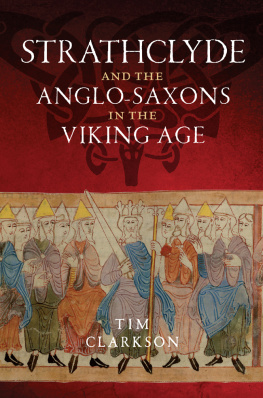THE VIKING AGE
Charles Francis Keary
PERENNIAL PRESS
Thank you for reading. In the event that you appreciate this book, please consider sharing the good word(s) by leaving a review, or connect with the author.
This book is a work of nonfiction and is intended to be factually accurate.
All rights reserved. Aside from brief quotations for media coverage and reviews, no part of this book may be reproduced or distributed in any form without the authors permission. Thank you for supporting authors and a diverse, creative culture by purchasing this book and complying with copyright laws.
Copyright 2016 by Charles Francis Keary Interior design by Pronoun Distribution by Pronoun
TABLE OF CONTENTS
HEATHENDOM
THERE ARE FEW PHYSICAL features in our Europe today more impressive than the remains of those Roman roads which once traversed every land owning the Roman sway, and which have withstood so wonderfully the wear of time. In every western country of Europe traces of these roads are to be found still recognizable, though in most they have been absorbed into a more modern system. Such has been the case with us as in France. But still the ancient highways can be well made out our Watling Street, Fosse Way, Icknield Street, Ermine Street. In many parts of Spain these Roman roads remain untouched, but grass-grown and half-ruined, while beside them run the mule-paths, which are all that the indolent country now cares to keep in repair and use. Each one of these roads is a natural symbol of the state which brought it into existence, in its directness of purpose, its unswerving determination and contempt of obstacles, and likewise in a certain prosaic plainness. Yet we cannot call these roads prosaic in the sum, so inimitable are they in their vast, undaunted length, and even in the uniformity of their plan. Standing upon them you realize better than in any other way the long arm of Roman justice. If you put your ear to them, and the cloud-gates of Time will roll aside for a moment for you, you may still hear along all their length the tramp of legionaries, the challenges of the guard, the hurrying feet of merchants or of slaves; and you will reflect, with pleasure or the reverse of it according to your bent, how these were once the iron girdles which bound together all the members of a mighty empire in an unchanging rule of justice and of law.
From Italy into France these roads made their way by the Riviera, or by the valleys of the two Doras (Durias), by Mont Genvre to Brianon, or by the Little St. Bernard; and either way at last to Lyons, which was the heart of all the Roman rule in Gaul. From Lyons again they led on by Chalons, Auxerre, Troyes, the other Chalons, to Rheims; from Rheims by Amiens to Boulogne; and then with but a narrow strip of intervening sea to Lymne, or Dover, or Richborough, or Ramsgate;[1] thence to Canterbury. When there they turned into that greatest of our highways, Watling Street, as the English came to call it; for it had its counterpart in the great highway which runs through the heavens. Watling Street leads on through London to Wroxeter; thence to Chester; and from near Chester the Roman road runs due north past Manchester as far as Carlisle, that is to say, as far as Hadrians wall. On the east side there is a corresponding road which runs past Lincoln to the ford across the Humber, to many other chesters in the north, Binchester, Lanchester, Ebchester and Chester le Street (the Castrum on the Roman road), up likewise to Hadrians wall and beyond it.
Across the Pyrenees and into Spain these roads penetrated on either side where the great mountain range dips down to the sea; on the east from Narbonne to Figuras, from Figuras to Gerona; on the west from Bayonne to St. Jean de Luz and Tolosa. There was likewise on this west side another way from Dax, north of Bayonne, almost due south, through a pass in the Pyrenees to Pampeluna. The pass thus formed became in later years very famous as the pass of Roncesvalles. Once beyond the Pyrenees the Roman roads spread out a network over all the Spanish peninsula.
Through the Eastern Alps, too, the roads made their way, over the Brenner and over the Splgen and down the Swiss valley of the Rhine. Ammianus Marcellinus, describing the dark, swampy, and forbidding character of this last region the approach to Lake Constance adds that nevertheless the Romans, with their usual good sense, have made a good road thither[2] that is, to Brigantia, or Bregenz. East of the Upper Rhine and south of the Upper Danube, at Ulm, at Regensburg, these roads are still to be found. But as we travel northward the Rhine more and more becomes the dividing line between Rome and not-Rome, and you come to the true German Germany (deutsches Deutschland), a region into which the Romans looked, and in which their armies marched and countermarched, but which never bent to their imperial sway.
Those who are all for classing us with the rest of the Teutonic nationalities cannot get over the existence of these Roman roads in England, and all that they imply. These roads were the veins along which flowed into Western Europe, first, the laws and customs of Rome, afterwards its religion, though this last probably never reached the extremities. It was vigorous in Gaul Proper, where all national life centred around the great altar of Rome and Augustus at Lyons; but it was weak by comparison in the German provinces (Germania Superior, Germania Inferior[3]), and in Britain. When the religion of Rome changed from Paganism to Christianity, Christianity in its turn travelled by the same routes, but made its way further than Paganism had ever done.
It was only for a short time that Britain was cut off from connection with the Continent. When the great age of Sturm und Drang the age of what are called the Folk-wanderings (Volkerwanderungen), and of the fall of Rome had passed, these shores were again brought into connection with Gaul, were once more visited by Gaulish vessels and Gaul by English. Only in the interval both lands had been overrun by a Teutonic conqueror. Gaul was on the highway to change into Francia France; and Britain was becoming, or had become, England.
*
Only a short time did the interruption of intercourse between Britain and the Continent endure. But still there was an interruption; and it so happens that the mythology of that interval has left us a precious relic which typifies what in the eyes of men who still made part of the world of the Roman Empire was the condition of those who had been separated from it. The relic I speak of is the myth current among the fishermen of Northern Gaul touching the mysterious island Brittia; a place as they deemed to which souls were wafted after death, where, as Claudian thought,[4] Ulysses had invoked the shades from Hades and poured blood into his trench
Est locus, extremum pandit qua Gallia littus,
Oceani praetentus aquis, ubi fertur Ulixes
Sanguine libato populum movisse silentem.
Illic umbrarum tenui stridore volantum
Flebilis auditur questus. Simulacra coloni
Pallida defunctasque vident migrare figuras.
The same myth, as Procopius relates it in prose, is of an island, Brittia, half of which was a habitation for the living, but the other half was set apart to be the home of ghosts. Between the two regions stretched a wall which none could pass and live; whoever did cross it, instantly fell dead upon the other side, so pestilential was the air. But serpents and all venomous things dwelt on the other side, and there the air was dark and spirit-haunted. The fishermen upon the Gaulish coast were made the ferrymen of the dead, and on account of this strange duty, we are assured, they were exempt from the ordinary incidence of taxation. Their task fell upon them in rotation; those villagers whose turn had come were awakened at dead of night by a gentle tap upon the door, and a whispering breath calling them to the beach. There lay their boats, empty to all appearance, and yet weighed down as if by a heavy load. Pushing off, the fishermen performed in one night a voyage which else they could hardly accomplish, rowing and sailing, in six days and nights. When they had arrived at the unknown coast, they heard names called over and voices answering as if by rotation, while they felt their vessels gradually growing light; at last when all the souls had landed the boats were wafted back to the habitable world.[5]









